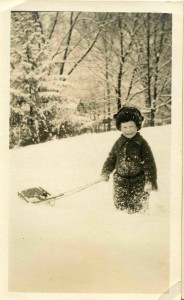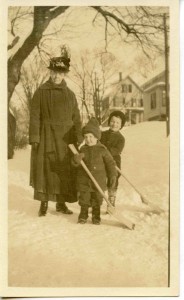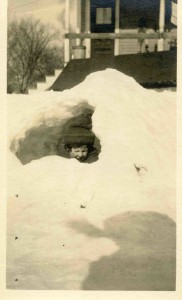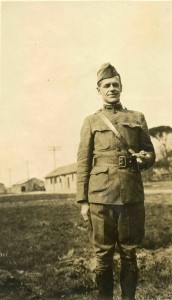New Hampshire, Real People, Woodman Family, World War I »
Winter, 1919
February 9, 2015 | 3 Comments | Betsy Woodman
We’ve just had the umpteenth snowfall of the season, and I hear the scrape of my neighbor’s shovel and the rumble of snow plows going by. On Facebook, there are dozens of pictures of snow banks, snow plows, snow forts, snow angels made by little kids.
Sifting through old family photographs, I come across similar photographs taken in January, 1919, in Franklin, NH. New-fallen snow there, too, and children in snowsuits. Like this pic of my dad shortly before his third birthday, pulling his sled.
Here’s another photo of him with his older brother, Jim, and their grandmother, Ida Everett, born 1855. So this is what a hip sixty-four-year-old grandma looked like in 1919! She was a force to be reckoned with, a staunch feminist and activist for women’s suffrage. “Why!” my dad used to say, “She stomped right down to Washington and chained herself to the White House fence.”
Moving on from Greatgrandmother Ida, I found this pic of my dad peeking out from a little snow cave.
I confess, it didn’t have much significance for me–until I turned it over. On the back, in my grandmother’s backward-sloping handwriting, was an inscription, faded but still legible: “Everett in the foreground, garbage pail in the background. Both will probably look good to you.”
Below that, obviously at a later date, she’d added: “Sent to Dad in France in 1919.”
Oh, my! All of a sudden that photo took on a deeper meaning. My grandmother had sent it to my granddad when he was overseas, serving as the commanding officer of a US military hospital during World War I.
He got to France shortly after the armistice of November 11, 1918, but that doesn’t mean he missed active duty service. Even after the shooting stopped, there was a horrendous amount of work to be done.
Patching people up.
“Reconstructive surgery” was the my granddad’s mission, getting wounded soldiers back into some semblance of functioning shape, so they could “get on with their lives.”
The US Army histories of the era have detailed records of operations performed, with photographs of grisly facial injuries (very common in World War I) treated by the surgeons. Many of the deformities are so bad that you’re not supposed to see them on the Internet unless you are over eighteen years of age.
In addition to the plastic surgery performed at Base Hospital 111, there were endless amputations and bone grafts to be done, delicate wound debridements and burn treatments. Sick and wounded soldiers continued to pour in from recent battle fields. For the combatants, war doesn’t end just because the shooting has stopped.
The 1,000 bed hospital was in Beau Desert, near Bordeaux, France, and it was in operation for about six months. During that time, in addition to daily sick call for 1,300 prisoners of war, the base personnel handled approximately 7,000 surgical and medical cases.
My granddad would later drily summarize his experience by saying that he learned a lot of new surgical techniques on that assignment.
It’s comforting and a bit poignant to think that in odd moments he smoked a cigar and perused the photos of his kids sent to him by his wife back in New Hampshire.
Lt Col James B. Woodman, MD, in Beau Desert, France, 1918 or 1919
All photos from Woodman family collection.









To me this was so touching! Even the garbage pail on the back porch would be a reminder of the dear quotidian back home!
Thank you, Betsy. Charming and meaningful.Let’s hear more. Love, Lois
Bets, you carry me from the present, to the recent past, to the distant past. Deformities you have to be 18 to see? Oh, my. I’m beginning to see images of Walt Whitman’s work on the Civil War battlefield. Thanks for this piece.